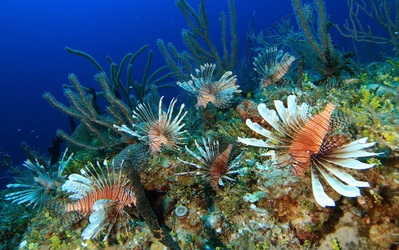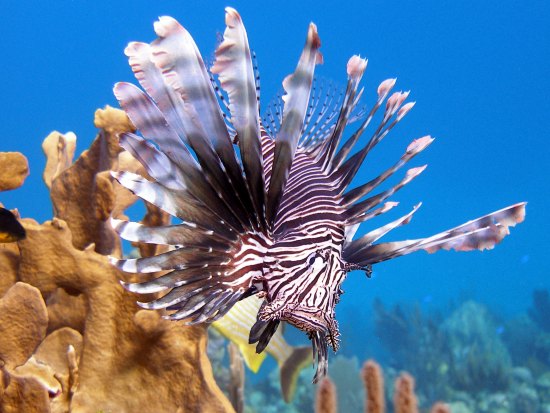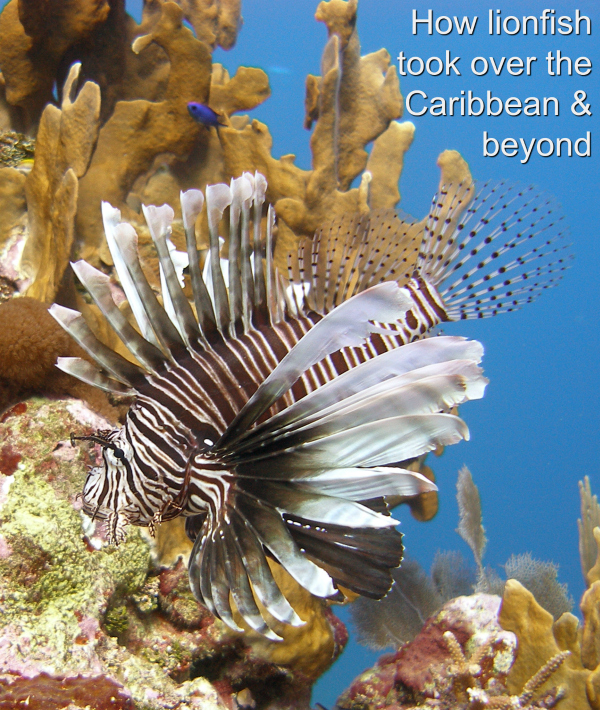
I live in Grand Cayman (The Cayman Islands) and we spotted our first lionfish on East End where I live in September 2009.
24 years prior to that in 1985 the first lionfish was spotted off of Dania Beach in Florida. There are 3 often-told stories or theories of how lionfish found their way into the waters around Florida, which are as follows:
- The deliberate release of lionfish by owners from their fish tanks at home.
- Six individual lionfish were released into Biscayne Bay during Hurricane Andrew in 1992 when an aquarium on the beach-side broke open.
- Lionfish, or much more likely eggs or larvae, were taken on board by large freighters in their ballast tanks and transported through the Panama Canal and unwittingly released into Florida waters at the end of their voyage.
So which of the stories is correct?
It turns out that story number 2, the Hurricane Andrew story, has never actually been verified. The author of that story advised that the information was never intended to document the source of the invasion. Also, the first lionfish was spotted in Florida waters in 1985, 7 years before Hurricane Andrew in 1992, albeit did that lionfish ever find a mate? And finally regarding the Hurricane Andrew story genetic investigation of tissue samples has also disproven this single-release theory.
With regards to story number 3, the ballast tank story. How can this story ever be actually 100% proven wrong? This, however, doesn’t mean the story is correct.
Which leaves story number 1. The genetic work which disproved the single-release theory (Hurricane Andrew) actually pointed to a multiple release event that included at least 10 lionfish. So today’s researchers believe that story number 1 is correct, that quite a number of idiots in Florida decided to take their pet lionfish called bubbles down to the ocean and release them. A bit like those idiots in Florida who released their pet Burmese Pythons into the Everglades. Not that I can talk. I’m British and we have a horrendous history as a nation, of releasing animals into other countries that we “colonised” that went onto decimate the local native species.
How quickly did they spread and to where?
So that is the story of how lionfish most likely found themselves in Florida waters. However, what happened next? Please see below the animated timeline map from 1985 to 2014 showing the spread of lionfish throughout the Western Atlantic Ocean, Gulf Of Mexico and the Caribbean Sea. Thanks To REEF for giving me permission to using this timeline.
 That timeline actually looks like a virus spreading. So…
That timeline actually looks like a virus spreading. So…
Lionfish Invasion. How they took over the Caribbean and beyond
Lionfish are really amazing fish. It is as if they were designed by a mad scientist to take over the world. The timeline above shows the spread of lionfish year by year throughout the Western Atlantic Ocean, Gulf Of Mexico and the Caribbean Sea. But what is it about lionfish that made this happen in such a short period of time? These are some of the “mad” facts about lionfish that made this happen:
- They are NEW to these waters. The native, and very regularly naive, local fish don’t know what they are, they don’t have any evolutionary history with the lionfish which is why most of them end up in the lionfish gut. Also, the predatory fish in the food-chain seem at present to not recognise them as a meal, or know how to approach them. (Although maybe the groupers are learning fast.)
- Unlike most fish, these guys have an amazing defence. They have 18 venomous spines, containing a proteinaceous neurotoxin, distributed around their body that deters predator fish from eating them, particularly when they point their head away and their spines towards the threat.
- They are extremely adaptable living at depths all the way down to 1000ft. They can also live in mangroves as well as brackish water. And they can tolerate water temperatures all the way down to 50 degrees Fahrenheit (10 degrees Celsius). I live in Cayman and I don’t like temperatures less than 80 degrees.
- The females are able to produce 2 egg sacks every 4 days and these egg sacks can contain 15,000 (Fifteen THOUSAND) eggs in each egg sack. The result can be 2,000,000 (2 MILLION) eggs per female per year. Even worse than the fact that each female can produce up to 2 MILLION eggs per year, the eggs are retained in a mucus ball (gelatinous mass) containing a noxious chemical, which means that many more of the eggs hatch compared to other fish because the eggs are much less likely to be eaten than some others.
- They are NOT picky eaters. They can eat over 70 species of fish and many invertebrate species, and they are able to eat prey that is up to half their body length. So whatever environment they find themselves in, they still thrive and are not going hungry.
- Lionfish are susceptible to very few parasites compared to other fish, which allows them to spend maximum time hunting and eating.

Can the lionfish invasion be stopped?
Absolutely not – they are an unstoppable force now. How far and wide they will spread, no one yet knows. That depends on how much they can adapt to the more extreme conditions. Could we see lionfish off the coast of Canada? No one yet knows the extent of their final domination.
But locally in small areas, with careful management, they can at least be contained and their sizes and numbers kept down with regular, near constant removal.
Here in The Cayman Islands, we are trying to stop these lionfish from taking over. The Department Of Environment regularly organises lionfish derbies (hunts). Also, local dive companies regularly organise lionfish hunts. The dive operation I work for (Tortuga Divers) does lionfish hunts every Tuesday and Thursday afternoon with the customers pointing them out and the guides spearing them. We manage to keep our dive sites pretty clear with this constant attention, but between the dive sites?
I also do my bit here with my wife, going out as many weekends as possible to catch them. Our record is 54 in one dive. We also caught 98 in just one day on 3 dives. Over the last couple of years we’ve certainly noticed in the main that the size of the lionfish in the areas we cover are smaller, and there are less now on sites we maintain than a few years back, so we certainly very much hope we are having at least a small positive impact with our work.
Happy hunting. Remember Kill ’em and Grill ’em.
PS. Thanks to Richard Carey for letting me use the picture at the top of this page.










Congratulations on the new site, Nigel; you are a one-man marine ecology task force!
Over the past five years, my daughter Evelyn and I have taken numerous trips with Tortuga Divers, and we’ve learned a lot about lionfish in the process. The dive scene on the East End, and your site in particular, are a great lesson in how effective local conservation efforts can be — you guys are making a real difference. Safe hunting!
Thank you Eric. I’m trying to do my bit for the island. We caught 46 lionfish on 2 dives yesterday, so that’s a few more native fish saved for a while longer. Nige